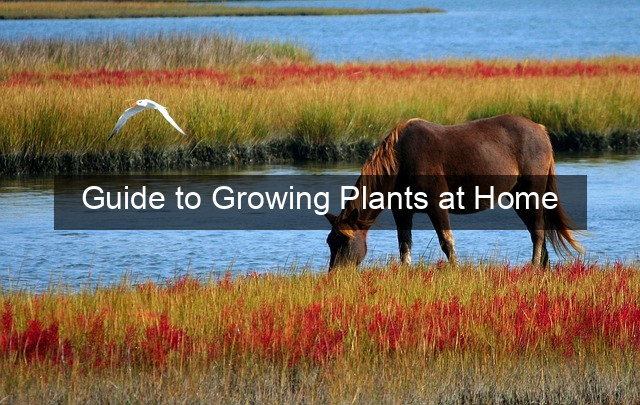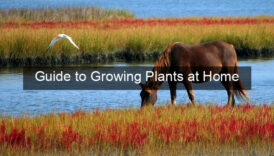Guide to Growing Plants at Home

- Guide to Growing Plants at Home
- A Comprehensive Guide to Growing Plants at Home
- Choosing the Right Plants
- Light Requirements
- Watering Needs
- Soil and Nutrients
- Creating the Ideal Environment
- Temperature and Humidity
- Pest and Disease Control
- Propagation Techniques
- Stem Cuttings
- Division
- Conclusion
- Frequently Asked Questions
- What are some easy-to-grow plants for beginners?
- How often should I fertilize my houseplants?
- How can I tell if my plant is rootbound?
- What should I do if my plant has pests?

A Comprehensive Guide to Growing Plants at Home
Imagine stepping into your home, greeted by the vibrant green of thriving plants, purifying the air and adding a touch of nature’s tranquility to your space. Growing plants at home is more than just a hobby; it’s a rewarding experience that connects you with the natural world, enhances your living environment, and even provides fresh herbs and vegetables right at your fingertips. Whether you’re a seasoned gardener or a complete novice, this guide will equip you with the knowledge and tools you need to cultivate a flourishing indoor garden. From choosing the right plants for your space to understanding their specific needs, we’ll cover everything you need to know to nurture your green companions and enjoy the fruits (and flowers!) of your labor. Get ready to transform your home into a verdant oasis.
Choosing the Right Plants
Light Requirements
Understanding the light requirements of your chosen plants is crucial for their survival and growth. Different plants have different light needs, ranging from full sun to low light conditions. Assess the light levels in your home, considering the direction your windows face and the amount of natural light they receive. Choose plants that are well-suited to the available light in your space. For example, succulents thrive in bright, direct sunlight, while ferns prefer shaded areas.
If you have limited natural light, you can supplement it with artificial grow lights. These lights mimic the spectrum of sunlight and can provide the necessary light energy for photosynthesis. Be sure to choose the right type of grow light for your plants and position them at the appropriate distance to avoid burning the foliage.
Observe your plants regularly for signs of light stress. If a plant is receiving too much light, its leaves may appear scorched or bleached. Conversely, if it’s not receiving enough light, it may become leggy and its growth may be stunted. Adjust the plant’s location or provide supplemental lighting as needed.
Watering Needs
Watering is essential for plant growth, but overwatering can be just as detrimental as underwatering. Different plants have different watering requirements, so it’s important to research the specific needs of your chosen plants. A general rule of thumb is to allow the top inch of soil to dry out before watering again.
The type of pot you use can also affect watering frequency. Terracotta pots are porous and allow for more evaporation, while plastic pots retain moisture for longer. Consider the material of your pot when determining how often to water your plants.
Pay attention to signs of overwatering or underwatering. Overwatered plants may exhibit yellowing leaves, root rot, and a generally wilted appearance. Underwatered plants, on the other hand, may have dry, crispy leaves and drooping stems.
Soil and Nutrients
The right soil provides essential nutrients and support for healthy plant growth. Most houseplants thrive in a well-draining potting mix that is rich in organic matter. Avoid using garden soil, as it can be too dense and may harbor pests or diseases.
Fertilizing your plants regularly will provide them with the necessary nutrients for optimal growth. Choose a balanced fertilizer that is appropriate for your specific plants and follow the instructions on the packaging carefully. Over-fertilizing can be harmful, so it’s always better to err on the side of caution.
Repotting your plants periodically will give them fresh soil and more room to grow. Choose a pot that is slightly larger than the previous one and use fresh potting mix. Be gentle when handling the roots to avoid damaging them.
Creating the Ideal Environment
Temperature and Humidity
Most houseplants prefer temperatures between 65 and 75 degrees Fahrenheit. Avoid placing your plants near drafts or heating vents, as these can cause temperature fluctuations that can stress the plants.
Humidity levels are also important for many houseplants. If your home is dry, you can increase humidity by grouping plants together, placing them on a tray of pebbles filled with water, or using a humidifier.
Monitor the temperature and humidity levels in your home and adjust them as needed to create a comfortable environment for your plants.
Pest and Disease Control
Regularly inspect your plants for signs of pests or diseases. Common houseplant pests include aphids, mealybugs, and spider mites. If you notice any pests, treat them promptly with an appropriate insecticide or natural remedy.
Diseases can also affect houseplants. Overwatering, poor air circulation, and unsanitary conditions can all contribute to the development of diseases. Practice good hygiene by cleaning your tools and pots regularly and removing any dead or decaying plant material.
Prevention is key when it comes to pest and disease control. By providing your plants with the proper care and environment, you can minimize the risk of infestations and diseases.
Propagation Techniques
Stem Cuttings
Propagating plants from stem cuttings is a simple and effective way to expand your collection. Take a cutting from a healthy stem, remove the lower leaves, and place it in water or moist potting mix. Keep the cutting in a warm, bright location and wait for roots to develop.
Different plants root more easily than others, so research the specific requirements for your chosen plant. Some plants may benefit from the use of rooting hormone to encourage root development.
Once the cutting has rooted, you can transplant it into a pot with fresh potting mix.
Division
Division is another propagation method that works well for certain types of plants. This involves separating a mature plant into smaller sections, each with its own roots and foliage. This is typically done when repotting a plant.
Carefully remove the plant from its pot and gently separate the roots. Replant each division in a separate pot with fresh potting mix.
Division is a great way to rejuvenate older plants and create new ones.
Conclusion
Growing plants at home offers a multitude of benefits, from enhancing your living space to providing a sense of accomplishment. By understanding the basic principles of plant care, you can create a thriving indoor garden that brings joy and tranquility to your life. Remember to choose plants that are suited to your environment and lifestyle, and don’t be afraid to experiment with different techniques. With patience and dedication, you can nurture your plants and watch them flourish, transforming your home into a green sanctuary.
As you embark on your plant-growing journey, remember that every plant is unique and requires specific care. Observe your plants closely, learn their individual needs, and adjust your approach accordingly. Don’t be discouraged by occasional setbacks; even experienced gardeners face challenges. Embrace the learning process and enjoy the rewards of connecting with nature in your own home.
Frequently Asked Questions
What are some easy-to-grow plants for beginners?
Snake plants, spider plants, and pothos are all relatively low-maintenance and tolerant of a range of conditions, making them ideal for beginners.
How often should I fertilize my houseplants?
Most houseplants benefit from fertilization every 2-4 weeks during the growing season (spring and summer). Reduce or stop fertilizing during the dormant season (fall and winter).
How can I tell if my plant is rootbound?
Signs of a rootbound plant include roots growing out of the drainage holes, stunted growth, and the need for frequent watering.
What should I do if my plant has pests?
Isolate the affected plant and treat it with an appropriate insecticide or natural remedy. Be sure to follow the instructions carefully.
| Plant | Light | Water |
|---|---|---|
| Snake Plant | Low to Bright Indirect | Infrequent |
| Spider Plant | Bright Indirect | Moderate |
| Pothos | Low to Bright Indirect | Moderate |
- Choose the right plants for your space.
- Provide adequate light, water, and nutrients.
- Monitor for pests and diseases.
- Enjoy the beauty and tranquility of your indoor garden.


